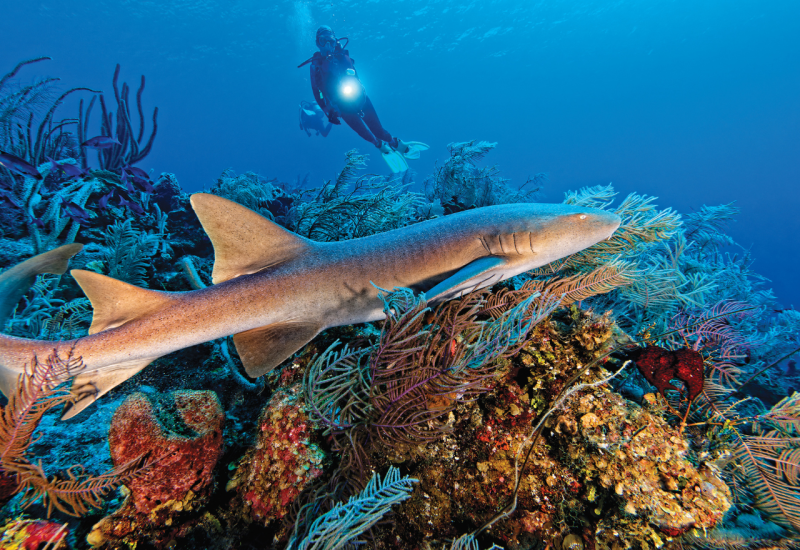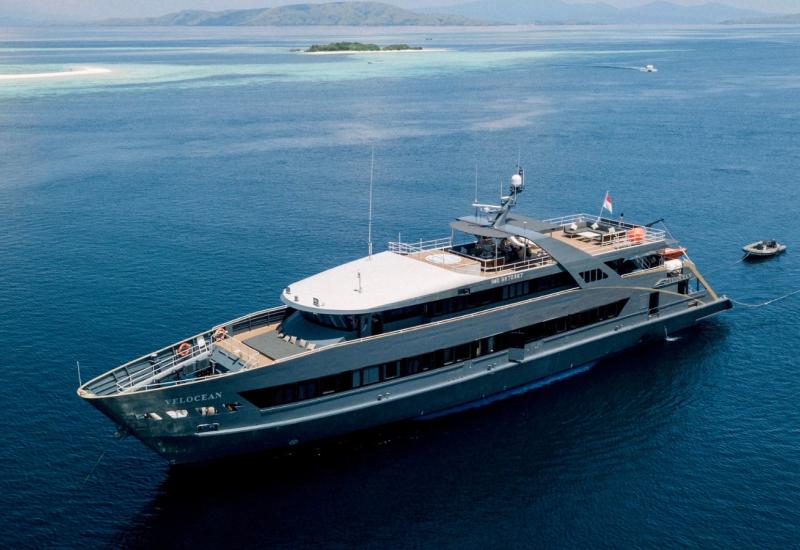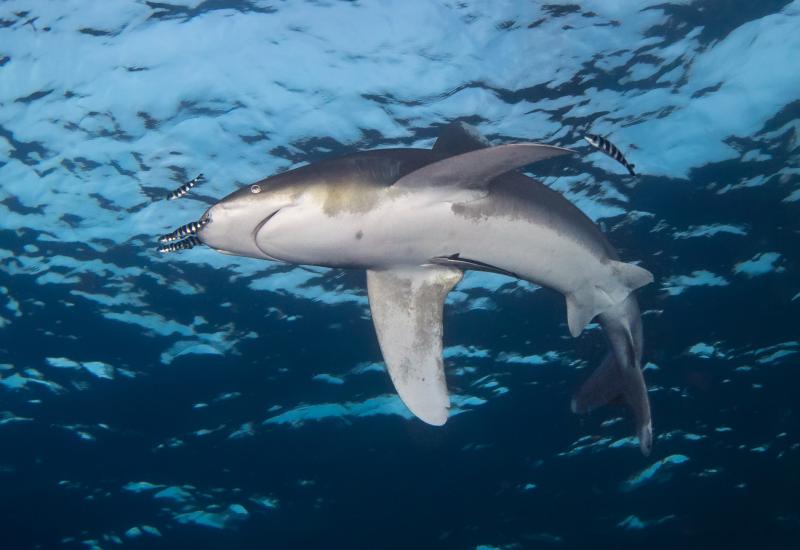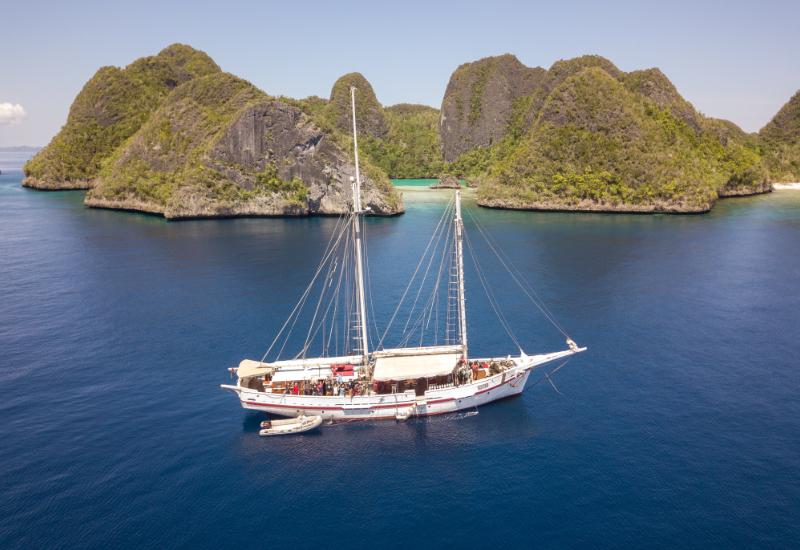Editor's Blog: Galapagos Days 1 & 2
Today is the start of a trip I’ve dreamt about since I learned to dive more than 20 years ago. I will be on board the Galapagos Sky for the next week, diving 5.5 days of the seven we’ll be in the islands.
I learned the hard way that a trip to dive the Galapagos doesn’t come easy. Two days ago I flew from San Francisco to Miami, then Miami to Guayaquil; yesterday a small group — including Peter Hughes and photographer Michele Westmorland, who I saw at the hotel breakfast — boarded a bus at the hotel, got on a flight and flew (first class, thanks to the Galapagos Sky booking agents!) to San Cristobal. We got on the boat, had a checkout dive in a little cove near the harbor, and settled down for dinner.
 This morning started bright and early with a trip to see the massive tortoises. Went ashore at Santa Cruz, an island northwest of San Cristobal, and were treated to a family of eagle rays: father, mother and little baby. They swam circles around the two tenders for about 10 minutes, and while the early-morning sun prevented great photography (for those of us without a polarizer), photographer Michele Westmorland got off a few great shots. There was a small pinnacle in water that was around 20 feet deep I’d guess, with sea lions playing in the water. It reminded me again how wild this place is and how lucky I am to be here.
This morning started bright and early with a trip to see the massive tortoises. Went ashore at Santa Cruz, an island northwest of San Cristobal, and were treated to a family of eagle rays: father, mother and little baby. They swam circles around the two tenders for about 10 minutes, and while the early-morning sun prevented great photography (for those of us without a polarizer), photographer Michele Westmorland got off a few great shots. There was a small pinnacle in water that was around 20 feet deep I’d guess, with sea lions playing in the water. It reminded me again how wild this place is and how lucky I am to be here.
Santa Cruz has the largest population in the Galapagos, with 22,000 people, and as we drove across the island I saw lone huts, evidence of some low-impact wood-cutting with planks of finished wooden planks lying next to the tree that had been felled, feral dogs, and herds of cows.
Our first stop was at “Rancho Primitiva,” a protected area where herds of giant Galapagos tortoise roam the grounds. These tortoises, as we saw from a one-hour visit, are anywhere from 100 lbs to around 400 lbs, and several feet long. The big ones are BIG, and they move as if they’ve got some extra pounds, going about as fast as a slow baby crawl.
Visitors are only allowed to within six feet of a tortoise, unless of course they start chasing you. None chased me, sadly, but the wild grounds — large clearings bound by groves of low-lying trees — provided good enough photo ops and excellent video, with the prehistoric beasts chowing down (and loudly) on grass.
We wandered the area to the “mud baths” where a half-dozen of the tortoises were basking in the mud. One had its head submerged entirely; photo-shy, I guess. Then we headed back around to the entrance where there’s a collection of souvenir shops.
Our next visit was to a lava tube a few minutes from the tortoise grounds. It was quite cool inside, in contrast to the heat and humidity outside, lit by incandescent bulbs every 20 yards or so. Open on both ends and quite large inside, so no chance of getting claustrophobic. After that we visited Los Gemelos, a pair of volcanic craters, before heading back to the boat.
The early afternoon was spent cruising to our late pm dives at Cousins Rock. I normally enjoy cruising — whether it’s the salt air, getting a tan, or watching dolphins play at the bow — but this was one of the best ever. Under bright blue skies I watched from the top deck as two species of petrels competed for air space, cruising along at 11 knots with our boat. Standing on a deck chair I got great video of them gliding from port to starboard and back again, before coming to rest on the radar equipment on top. We also saw several turtles, a lone hammerhead and, of course, dolphins that rode the bow. The first to join up put on quite an acrobatic show, leaping high into the air a pair of times before riding the bow wave.
Our dives at Cousins Rock were almost a letdown after that show. (Almost.) The first dive was “ordinary,” with subpar visibility and green water. Saw a couple turtles, a few black-blotched rays, a white tip shark, and a sea lion that buzzed us. At the surface we could see several fur seals and sea lions tanning in various ledges of the small volcanic island. (Good thing we didn’t have mantas mating with whale sharks, as this was my first dive testing out a GoPro Hero2. I have it neatly ensconced in a little Backscatter housing on top of a ULCS pistol-grip arm, all the better to film all the critters with.)
The second dive was much better, with more current and better visibility. We went around the eastern edge of the rock this time, pushing through some strong current to see masses of fish. The water was two distinct colors here — a murky green about 30 feet off the wall, and a vibrant blue that bathed the yellow soft corals and tubastreas. We had more luck here with marine life encounters, seeing a 500-strong school of barracuda, more black-blotched rays, several turtles, the sea lion (which was a bit friendlier this dive), and at the very end a lonesome eagle ray that swam around.
Celebrated a birthday tonight. Patricia (from Brazil), a new diver with 10 open-water dives to her name, enjoyed a cake topped by two sea lions.
Now we’re cruising on our way to Wolf and Darwin islands, where we’ll spend the next three days hopefully getting hammerheads and dolphins and mantas.
Today is the start of a trip I’ve dreamt about since I learned to dive more than 20 years ago. I will be on board the Galapagos Sky for the next week, diving 5.5 days of the seven we’ll be in the islands.
I learned the hard way that a trip to dive the Galapagos doesn’t come easy. Two days ago I flew from San Francisco to Miami, then Miami to Guayaquil; yesterday a small group — including Peter Hughes and photographer Michele Westmorland, who I saw at the hotel breakfast — boarded a bus at the hotel, got on a flight and flew (first class, thanks to the Galapagos Sky booking agents!) to San Cristobal. We got on the boat, had a checkout dive in a little cove near the harbor, and settled down for dinner.
 This morning started bright and early with a trip to see the massive tortoises. Went ashore at Santa Cruz, an island northwest of San Cristobal, and were treated to a family of eagle rays: father, mother and little baby. They swam circles around the two tenders for about 10 minutes, and while the early-morning sun prevented great photography (for those of us without a polarizer), photographer Michele Westmorland got off a few great shots. There was a small pinnacle in water that was around 20 feet deep I’d guess, with sea lions playing in the water. It reminded me again how wild this place is and how lucky I am to be here.
This morning started bright and early with a trip to see the massive tortoises. Went ashore at Santa Cruz, an island northwest of San Cristobal, and were treated to a family of eagle rays: father, mother and little baby. They swam circles around the two tenders for about 10 minutes, and while the early-morning sun prevented great photography (for those of us without a polarizer), photographer Michele Westmorland got off a few great shots. There was a small pinnacle in water that was around 20 feet deep I’d guess, with sea lions playing in the water. It reminded me again how wild this place is and how lucky I am to be here.
Santa Cruz has the largest population in the Galapagos, with 22,000 people, and as we drove across the island I saw lone huts, evidence of some low-impact wood-cutting with planks of finished wooden planks lying next to the tree that had been felled, feral dogs, and herds of cows.
Our first stop was at “Rancho Primitiva,” a protected area where herds of giant Galapagos tortoise roam the grounds. These tortoises, as we saw from a one-hour visit, are anywhere from 100 lbs to around 400 lbs, and several feet long. The big ones are BIG, and they move as if they’ve got some extra pounds, going about as fast as a slow baby crawl.
Visitors are only allowed to within six feet of a tortoise, unless of course they start chasing you. None chased me, sadly, but the wild grounds — large clearings bound by groves of low-lying trees — provided good enough photo ops and excellent video, with the prehistoric beasts chowing down (and loudly) on grass.
We wandered the area to the “mud baths” where a half-dozen of the tortoises were basking in the mud. One had its head submerged entirely; photo-shy, I guess. Then we headed back around to the entrance where there’s a collection of souvenir shops.
Our next visit was to a lava tube a few minutes from the tortoise grounds. It was quite cool inside, in contrast to the heat and humidity outside, lit by incandescent bulbs every 20 yards or so. Open on both ends and quite large inside, so no chance of getting claustrophobic. After that we visited Los Gemelos, a pair of volcanic craters, before heading back to the boat.
The early afternoon was spent cruising to our late pm dives at Cousins Rock. I normally enjoy cruising — whether it’s the salt air, getting a tan, or watching dolphins play at the bow — but this was one of the best ever. Under bright blue skies I watched from the top deck as two species of petrels competed for air space, cruising along at 11 knots with our boat. Standing on a deck chair I got great video of them gliding from port to starboard and back again, before coming to rest on the radar equipment on top. We also saw several turtles, a lone hammerhead and, of course, dolphins that rode the bow. The first to join up put on quite an acrobatic show, leaping high into the air a pair of times before riding the bow wave.
Our dives at Cousins Rock were almost a letdown after that show. (Almost.) The first dive was “ordinary,” with subpar visibility and green water. Saw a couple turtles, a few black-blotched rays, a white tip shark, and a sea lion that buzzed us. At the surface we could see several fur seals and sea lions tanning in various ledges of the small volcanic island. (Good thing we didn’t have mantas mating with whale sharks, as this was my first dive testing out a GoPro Hero2. I have it neatly ensconced in a little Backscatter housing on top of a ULCS pistol-grip arm, all the better to film all the critters with.)
The second dive was much better, with more current and better visibility. We went around the eastern edge of the rock this time, pushing through some strong current to see masses of fish. The water was two distinct colors here — a murky green about 30 feet off the wall, and a vibrant blue that bathed the yellow soft corals and tubastreas. We had more luck here with marine life encounters, seeing a 500-strong school of barracuda, more black-blotched rays, several turtles, the sea lion (which was a bit friendlier this dive), and at the very end a lonesome eagle ray that swam around.
Celebrated a birthday tonight. Patricia (from Brazil), a new diver with 10 open-water dives to her name, enjoyed a cake topped by two sea lions.
Now we’re cruising on our way to Wolf and Darwin islands, where we’ll spend the next three days hopefully getting hammerheads and dolphins and mantas.










